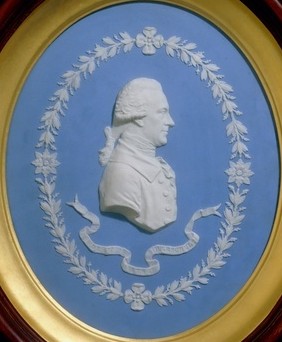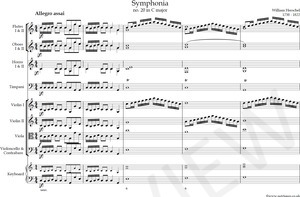 notAmos Performing Editions 1 Lansdown Place East, Bath BA1 5ET, UK +44 (0) 1225 316145 Performing editions of pre‑classical music with full preview/playback and instant download |
William Herschel
(1738 - 1822)

Symphonia nr. 20 in C major
(2Fl.2Ob.2Hn.Tmpi.2Vn.Va.Vc.Kbd.(optional))
Full score (PDF), €4.00 for a single copy Buy this item(1738 - 1822)

Symphonia nr. 20 in C major
(2Fl.2Ob.2Hn.Tmpi.2Vn.Va.Vc.Kbd.(optional))
Flute I part (PDF), €1.00 for unlimited copies Buy this item
Flute II part (PDF), €1.00 for unlimited copies Buy this item
Oboe I part (PDF), €1.00 for unlimited copies Buy this item
Oboe II part (PDF), €1.00 for unlimited copies Buy this item
Horn I in C part (PDF), €1.00 for unlimited copies Buy this item
Horn II in C part (PDF), €1.00 for unlimited copies Buy this item
Horn I in F part (PDF), €1.00 for unlimited copies Buy this item
Horn II in F part (PDF), €1.00 for unlimited copies Buy this item
Timpani part (PDF), €1.00 for unlimited copies Buy this item
Violin I part (PDF), €1.00 for unlimited copies Buy this item
Violin II part (PDF), €1.00 for unlimited copies Buy this item
Viola part (PDF), €1.00 for unlimited copies Buy this item
Violoncello and Contrabass part (PDF), €1.00 for unlimited copies Buy this item
Keyboard part (PDF), €1.00 for unlimited copies Buy this item
Printable cover page (PDF), €0.00 for unlimited copies Download this item
Score, part(s) and cover page (PDF), €12.00 for bundled copies Buy this item
If you have any problem obtaining a PDF, please see our help page. If that does not resolve the issue, please click here.
Click on the illustration to display a larger version
For licensing/copyright information please click here
| Enquire about this score |
| About William Herschel |
| Full Catalogue |
| About us | Help, privacy, cookies |
| About William Herschel |
| Full Catalogue |
| About us | Help, privacy, cookies |
Allegro Assai - Andante ma non troppo - Allegro assai
Herschel completed this symphony on 12th March, 1763 in Leeds.
Alternative horn parts are provided both for horns in C (Herschel's specification) and for horns in F.
Herschel's symphonies remained unpublished in his lifetime and were therefore rendered only under his personal direction, and only by the forces available to him. In the relevant period (during his employments in Northumberland, Durham and Yorkshire) his pools of available players were at comparatively small town music associations, with a small military band, and at a house party with royal guests. On Aug. 18th, 1761 he wrote from one of his more important engagements, in Newcastle, that "I have the direction of the music, and we make up a fairly good band of about 16 persons". This number would seem slightly larger than the forces he could generally muster, and consequently it would seem that he had, at best, only about a dozen string players at any rendition. The varying numbers of wind (and percussion) players prescribed for the different symphonies are an accurate indication of the supplementary forces available to him at any given composition's date.
Herschel completed this symphony on 12th March, 1763 in Leeds.
Alternative horn parts are provided both for horns in C (Herschel's specification) and for horns in F.
Herschel's symphonies remained unpublished in his lifetime and were therefore rendered only under his personal direction, and only by the forces available to him. In the relevant period (during his employments in Northumberland, Durham and Yorkshire) his pools of available players were at comparatively small town music associations, with a small military band, and at a house party with royal guests. On Aug. 18th, 1761 he wrote from one of his more important engagements, in Newcastle, that "I have the direction of the music, and we make up a fairly good band of about 16 persons". This number would seem slightly larger than the forces he could generally muster, and consequently it would seem that he had, at best, only about a dozen string players at any rendition. The varying numbers of wind (and percussion) players prescribed for the different symphonies are an accurate indication of the supplementary forces available to him at any given composition's date.
